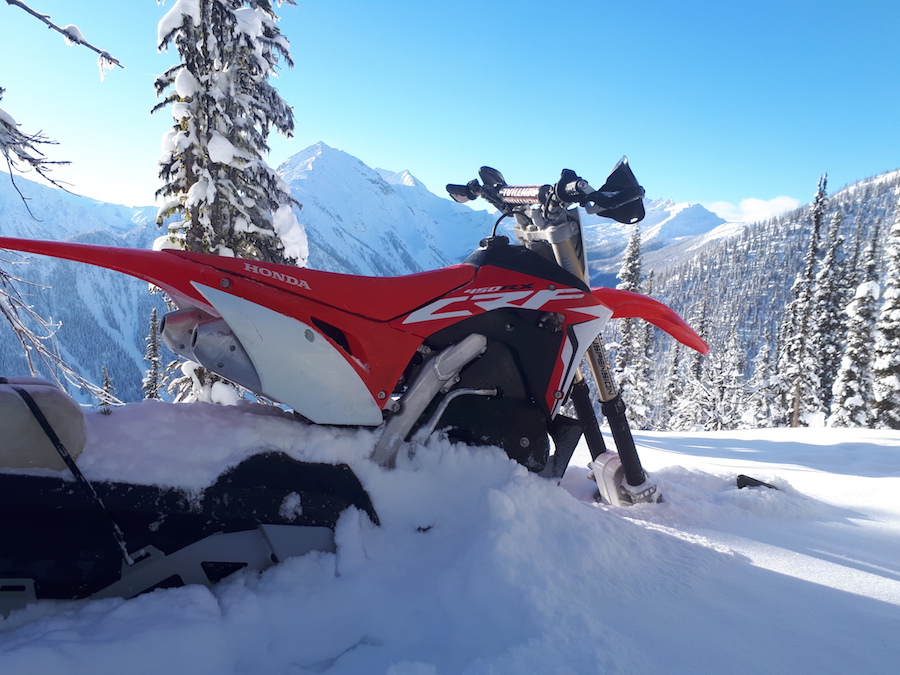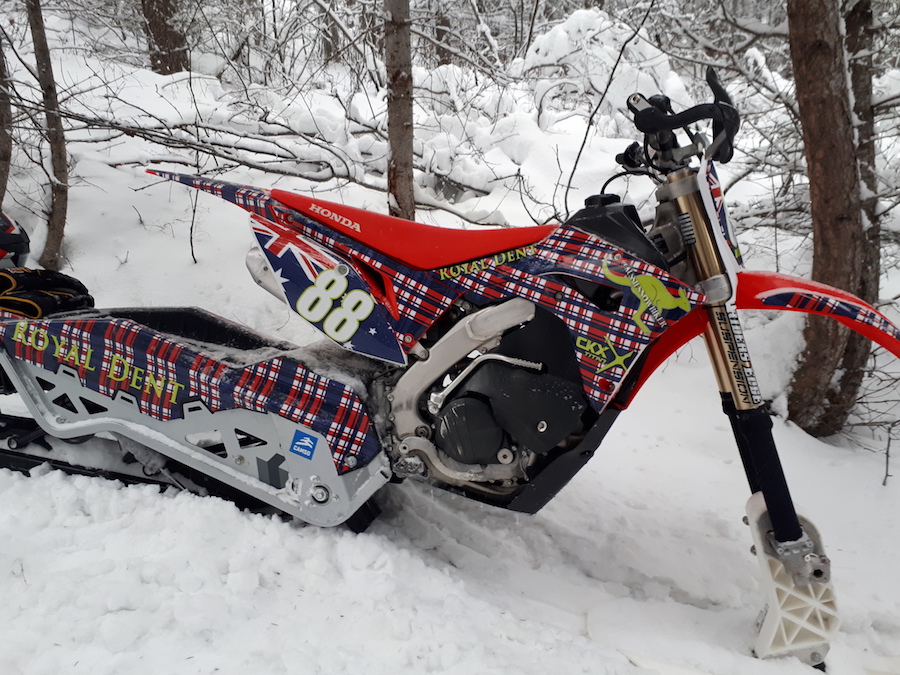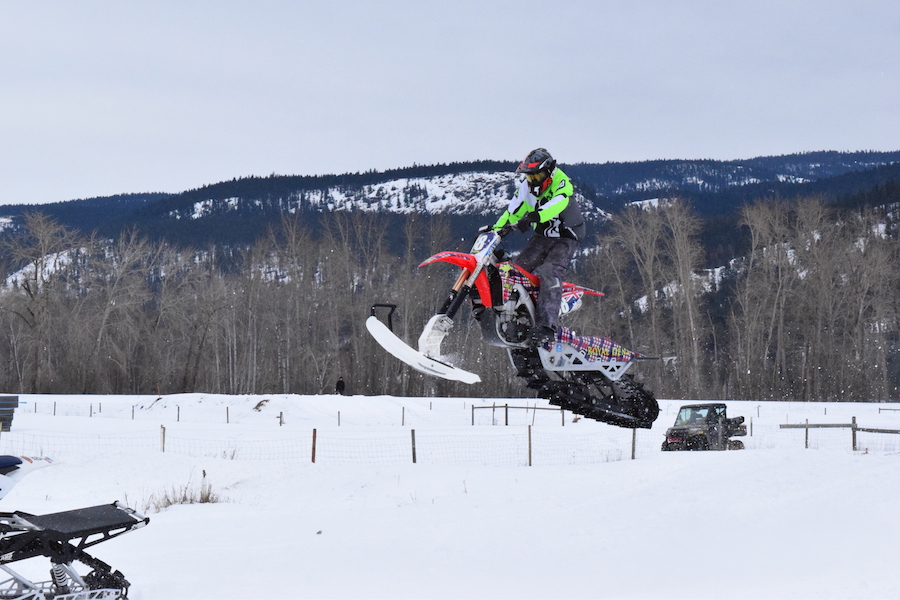How does a motocross rider from tropical Queensland end up taking on the Canadian snow gods at their own game? With a swag of Aussie spirit
Pounding through the powder on a crisp winter’s day aboard a motocross bike is now what dreams are made of. But three years ago I’d never even heard about the sport of snowbiking.
I recall it was a hot, sweaty night in Ambrose, Queensland, and I was planning a North American holiday in 2015 when I stumbled across it. Yet by January 2016 I’d competed in the AMA Snowbike Nationals in McCall, Idaho, placing 20th out of 56 riders.
Looking back, it is now hard to imagine life without snowbikes. The term ‘on any Sunday’ has a new meaning for me these days; now it’s a dawn-till-dusk event in negative whatever degrees with a couple of mates in search of the gnarliest lines in the backcountry of Canada’s British Columbia.
My first impression of snowbikes was horrible – it’s the worst handling bike I’d ever been on! The ski was darting around, the rear track was stiff on corners and trying to stand the bike upright when I was battling to get the thing to lean. But the moment I rode off hard-packed snow and into soft powder, everything changed. It just turned into an effortless, floating feeling – with the throttle pinned the whole time!
Imagine riding on an ocean of loamy sand where you can pick nearly any line for as far as the eye can see. If you ever stack, you’re landing in a soft, albeit cold, pillow – it’s pure happiness. At times the extra-soft snow leads you into snow-drowning moments, like when you catch a log buried under the snow, but you still enjoy every minute of it. It’s truly heaven on earth, where snowbikes rule!

Snow versus dirt
Other than the fact that you’re riding way above the ground on a pile of snow, the snowbike handles similarly to a dirtbike in terms of cornering and clutch control. The rest is a new game. The power delivery is not as potent, so you twist that throttle pretty hard all day, and it’s an awesome feeling, especially on a two-stroke.
When it comes to braking, there’s no front wheel, so no front anchor. There is a disc brake in the rear track system, which can be hooked up to either the rear pedal or the front brake lever. I opted for the pedal – not only does my brain feel better about it, but the ability to quickly tap the brakes while at full speed into a berm is worth it, for a race situation anyway. Most riders actually set it up to the lever. The benefit of that set-up is that the brake lever remains clear, while the pedal can get jammed up with ice on deep-powder days, making braking a little difficult.
When riding in the deep snow in the backcountry, brakes don’t work that well at all. They get iced up very quickly, so you need to pre-empt braking by pumping the brake well before you need it to ensure it actually grabs. Then, to make matters worse, they don’t stop downhill easily. Once the brake is applied, the track instantly builds up with snow, causing a toboggan effect. You kind of just have to wing it and throw the bike side to side as if it were a three-metre-long snowboard.
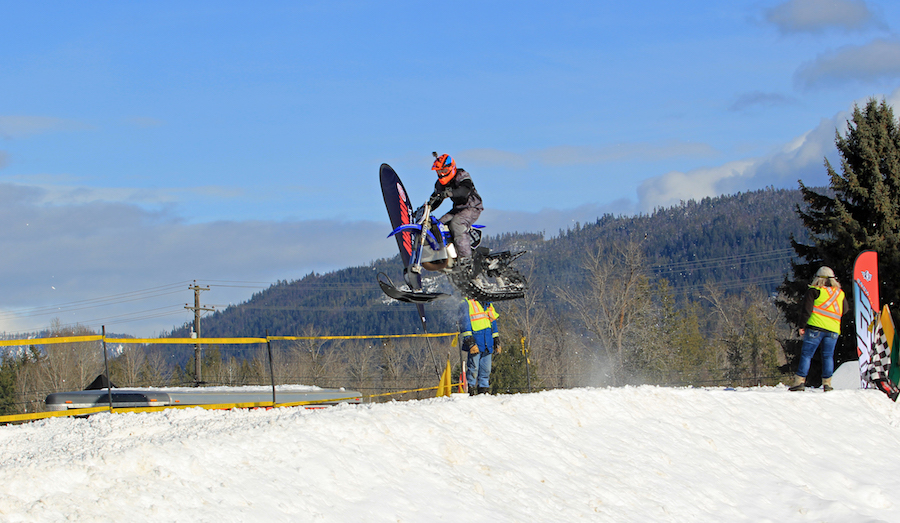
The races
There’s a wide variety of riders competing. There are the guys like me with backgrounds in motocross or enduro, including a bunch of pro riders from Canada and the US, and then there are some guys and girls who have never raced on dirt and who are now competing in the snow for the first time.
There are about 400 of us who race across America’s northwest and Canada, but only a handful are able to get to all the races, with usually somewhere between 50 and 70 competing at any one event.
The sport’s increasing popularity means there are more events now. The AMA now sanctions an official eight-round championship in the US, Motorsport Racing Canada (MRC)
runs a three-round domestic championship, and now even X Games hosts a snowbike class in Aspen, Colorado.
The first couple of seasons saw me competing at various AMA rounds as well as a few of the Canadian races, and with each race came another podium finish and advancement towards the Pro class. So when this season started, I knew I had to step it up a notch to complete an entire series and see if I could make it to Pro.
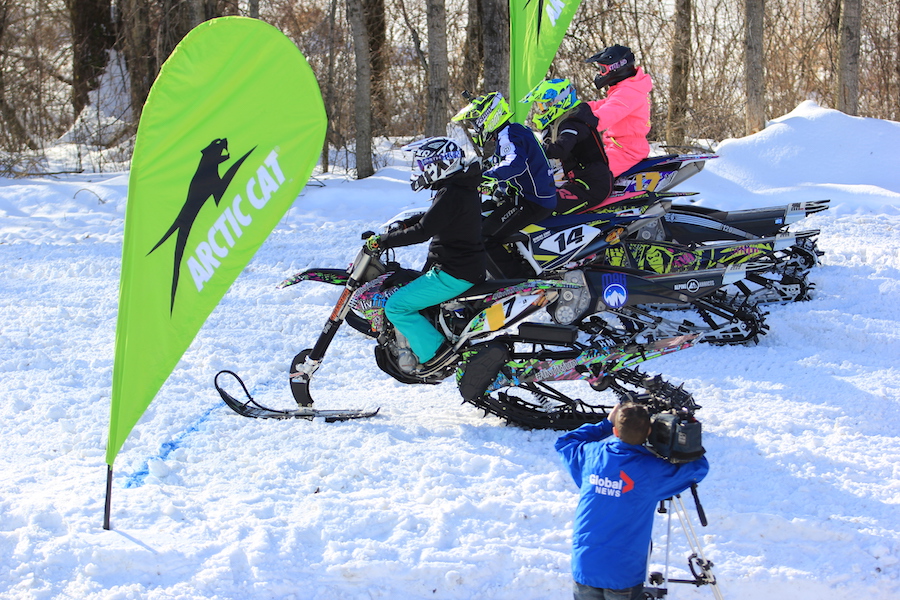
At first, the desire to travel to the US 10 times over three months to compete in both the AMA series and X Games was quashed. My wife and I were waiting for new work visas to stay in Canada longer, which meant if we left the country we couldn’t get back in. The Canadian Nationals was my one shot to prove that this ranga from tropical Queensland could mix it with the Canadian snow gods.
The 2018 Canadian Snowbike Nationals was held over three rounds in Sicamous, Kamloops and Revelstoke – all, thankfully, within a five-hour drive of where I live in Golden, BC.
At the opening round, the track was a nightmare. During the week leading up to the event, there was a blue between the event promoter and the local snowmobile club, which meant there wasn’t a snow-groomer for race day. It’s like arriving at a motocross track that hasn’t been prepped in 20 years and there’s no water truck on site.
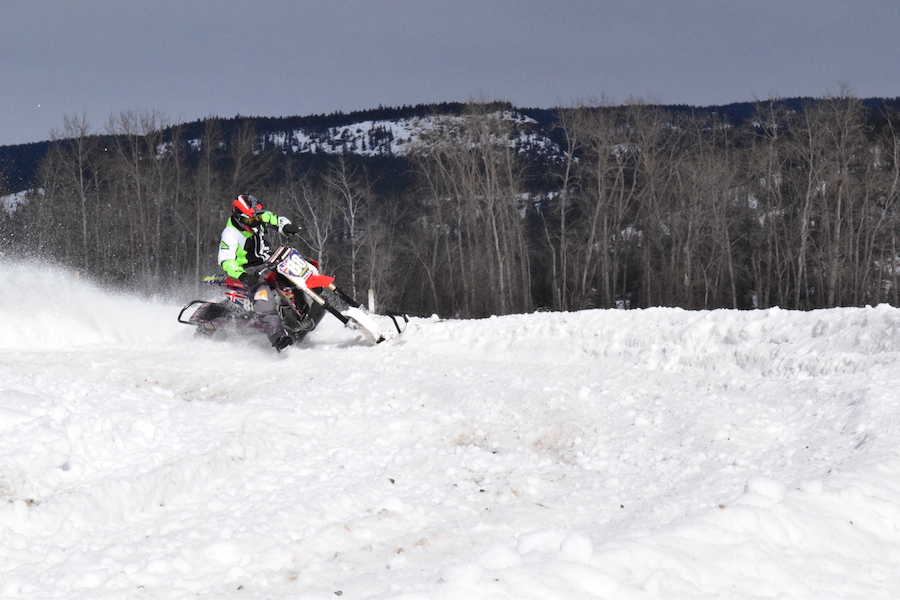
The track was solid ice. Snowbikes don’t really work on hard surfaces, so it was like wrestling a bull around a track for 10 minutes at a time. After running both Intermediate and Modified classes (winning one, second in the other), the promoter cancelled the Pro class. Thank god. My track kit was destroyed and I didn’t have an ounce of energy left to perform in a third.
Thankfully the conditions at the second round were awesome! We raced on the existing motocross track, which was nice and long, and with a couple of decent 60- and 80-foot jumps to boot. The snow groomer kept the snow in top shape from start to finish and the competition was tough.
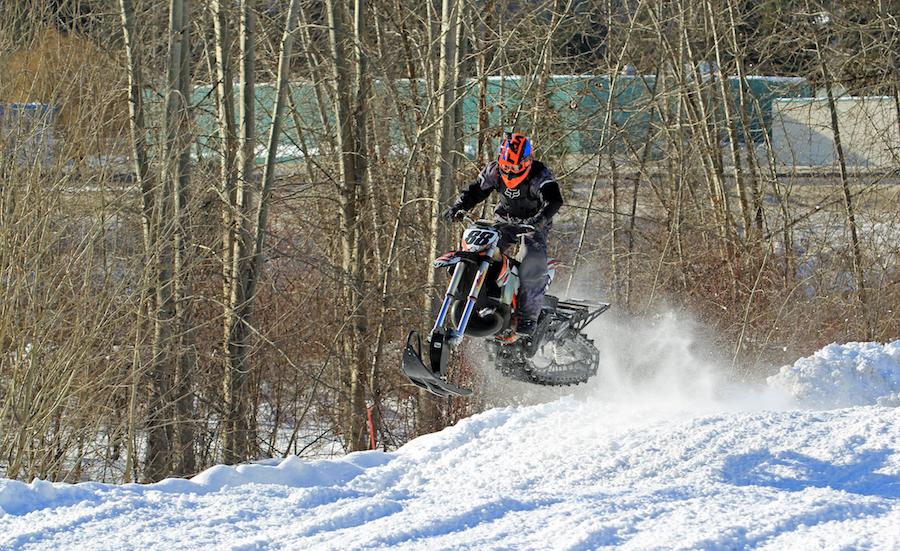
I was the only rider running in three classes, and on the third lap of the Pro qualifier I went to click fourth gear before sending it over a tabletop, and my transmission blew, nearly sending me over the ’bars. I soon realised my bike would only stay in fifth gear, and nothing else.
Needless to say, I was then slow off the line, but a good amount of clutch slip meant a slingshot performance at the end of the straight, so I could at least win back some positions lost at the start.
So it wasn’t a day of holeshots, but it made for a really fun day of high corner-entry speed to maintain fifth-gear drive and full clutching out of berms to make an 80-foot double with an ice landing. With a couple of last-lap crashes and tons of bike trouble, I still managed to walk away with second in each class, a completely wrecked bike, and a black big toe.
One of my younger rivals, Owen McKill, said to me after the first race: “Man, you were absolutely flying then!” To which I replied: “Dude, I’m stuck in fifth gear – I can only go fast!”
The third and final round was the best of the series. It was March and the temperature was rising, with a nice sunny day of around five degrees, which meant I could throw on my motocross gear for the first time in a snow race.
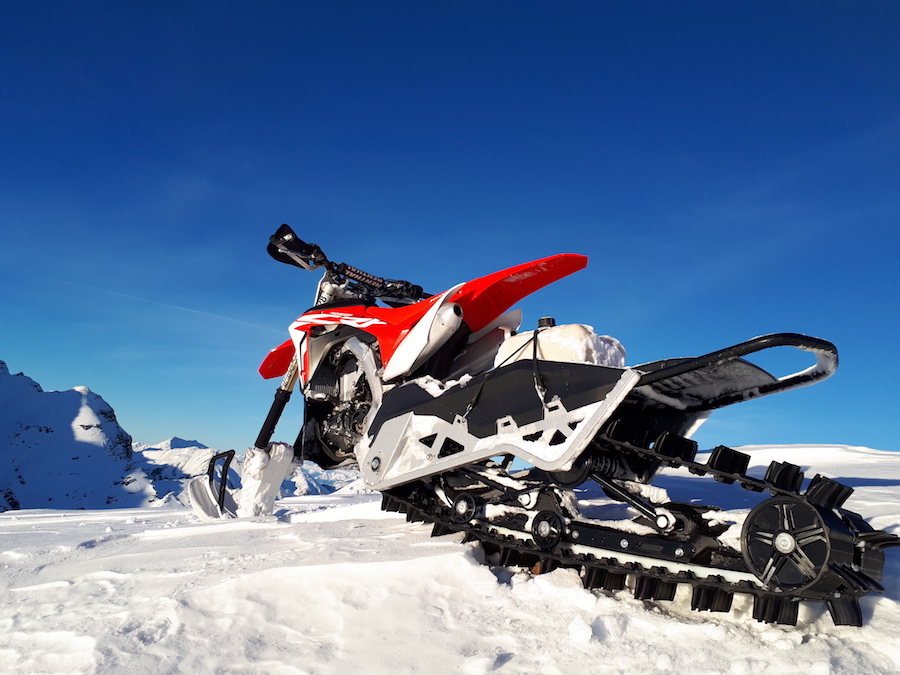
It felt so good to be wearing less gear – though it wasn’t waterproof and I ended up soaked and shivering, while scraping ice from my goggles over jumps. But the feeling of sending it during the race while looking at the crowd and seeing the Rocky Mountains over the top made everything else negligible.
To make things more interesting, I was forced to borrow a bike for the race. My usual race steed, a 2017 Honda CRF450RX with a Camso DTS 129-inch track with solid-strut mount – probably the most basic set-up one can race with – was still spread across my dining room waiting on the transmission parts that were still on back order. And, yes, my wife is awesome.
So, I raced a 2016 KTM 450 SXF with a Timbersled 120-inch track with shock mount (called a TSS) instead. The bike was set up completely different (and somewhat incorrectly), meaning the seat height was about 1200mm, and it performed strangely. Nevertheless, this was what I had to hold pinned for the day, and I did just that.
Unfortunately, during the third race the track kit started to ratchet after becoming loose and I fell to the back of the pack. We inspected and re-tensioned the track, which allowed me one more race before the kit exploded – breaking the suspension torque arms, rails and disc brake.
At this point, I had to borrow another bike in order to compete in the final Pro race of the season. This one – a 2018 Honda CRF450R with Timbersled ARO 120-inch – fortunately felt very similar to my bike, just better. I was able to secure a solid third place for the race and second overall in the series.

Exploring
Although there are a handful of snowbikers who love to race, I reckon the most exciting thing about riding these bikes is exploring the backcountry. We spend our days travelling as far into the mountains as possible by truck, then riding another 15-20km into the white wilderness, and use that point as a base for a day of awesome riding. Some days you don’t even know where you are after traversing 100km over three different mountain ranges…
Which brings me to fuel consumption. Four-strokes will use anywhere from 12 to 20 litres in a day, two-strokes from 20 litres upwards. My biggest day out was at Queest Mountain, Sicamous, BC, where I burned through the 24 litres I had with me, used my mates’ 12 litres of reserve, and still got towed 6km back to the ute.
The backcountry is usually accessible from November to May. Early- and late-season riding means some features – rocks, logs, creeks and holes – are still uncovered, so it can be sketchy, and it’s easy to damage the bike. Most riders will wait until the thick snow of December to avoid high-cost repairs and the risk of injuries.
The season for me starts at the end of October and I ride through until sometime in May. Most riders will stop much earlier due to the risk of running over dirt, rocks and creeks, and the increased risk of avalanches, but the diehards continue for as long as they possibly can. There are even a few guys who get their machines taken by helicopter way out in the backcountry during summer – that’s living!

There are many areas snowbikes can be ridden now, including most of the northern half of the US, most of Canada, Japan, parts of Europe, and now New Zealand. The best spots (at least in North America) are in the interior ranges (Monashees, Columbia and Rockies), where extremely high amounts of snowfall occurs and it is light and fluffy.
I’ve researched Europe and it appears their season is longer and the snowpack is significant, and jaw-droppingly steep terrain! The European market is slow, but I’m sure we’ll see some exciting creations from those engineers.
Everyone who has ridden in Japan has reported epic days of riding, so it is definitely on my bucket list to try. Japan is well known for its baby-powder fine snow and great vision.
It will be interesting to see how the New Zealand market goes, with recent news of a snowbike rental company starting up. The snow in New Zealand is said to be wet and heavy in comparison to the northern hemisphere, which I am assuming would provide a more tractable riding situation similar to spring snow here in Canada.
Snowbiking in Australia? Well, not just yet. With the amount of red tape put up for anything that involves a motorised device being used recreationally on crown land, I doubt the Australian government will ever allow it.
Words Shannon Mason
